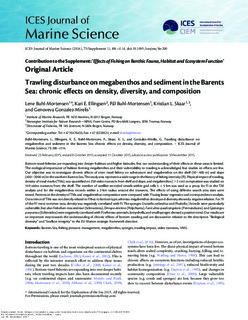Trawling disturbance on megabenthos and sediment in the Barents Sea: Chronic effects on density, diversity, and composition
Buhl-Mortensen, Lene; Ellingsen, Kari Elsa; Buhl-Mortensen, Pål; Skaar, Kristian Landmark; Gonzalez-Mirelis, Genoveva
Journal article, Peer reviewed
Published version

View/
Date
2016Metadata
Show full item recordCollections
- Publikasjoner fra CRIStin - NINA [2364]
- Scientific publications [1392]
Abstract
Bottom-trawl fisheries are expanding into deeper habitats and higher latitudes, but our understanding of their effects in these areas is limited.
The ecological importance of habitat-forming megabenthos and their vulnerability to trawling is acknowledged, but studies on effects are few.
Our objective was to investigate chronic effects of otter trawl fishery on substratum and megabenthos on the shelf (50–400 m) and slope
(400–2000 m) in the southern Barents Sea. The study area represents a wide range in the history of fishing intensity (FI). Physical impact of trawling,
density of trawl marks (TMs), was quantified on 250 video transects from shelf and slope, and megabenthos (.2 cm) composition was studied on
149 video transects from the shelf. The number of satellite-recorded vessels within grid cells 5 × 5 km was used as a proxy for FI in the TM
analysis and for the megabenthos records within a 2-km radius around the transects. The effects of using different search area sizes were
tested. Patterns in the density of TMs and megabenthos composition were compared with FI using linear regression and correspondence analysis.
Occurrence of TMswas not directly related to FI but to bottom type, whereas megabenthos density and diversity showed a negative relation. For 79
of the 97 most common taxa, density was negatively correlated with FI. The sponges Craniella zetlandica and Phakellia/Axinella were particularly
vulnerable, but also Flabellum macandrewi (Scleractinia), Ditrupa arietina (Polychaeta), Funiculina quadrangularis (Pennatulacea), and Spatangus
purpureus (Echinoidea)were negatively correlated with FI, whereas asteroids, lamp shells, and small sponges showeda positive trend. Our results are
an important step towards the understanding of chronic effects of bottom trawling and are discussed in relation to the descriptors “Biological
diversity” and “Seafloor integrity” in the EU Marine strategic framework directive.
Barents Sea, fishing pressure, management, megabenthos, sponges, trawling impact, video transects, VMS.